Abstract
Little is known about the state of experimentation in the field of medicine during the Medieval Islamic era. With few exceptions, most of the contemporary sources on history of medicine propagate the idea that the roots of experimental medicine in its modern form, including clinical trials and drug-potency studies, first started during the European Renaissance in the 16th to the 18th centuries. This study is part of an ongoing multidisciplinary primary-source investigation of the original Arabic works of 11 Islamic medical scholars who lived and practiced between the 9th and the 13th centuries. The study critically evaluated and documented their contributions to the development of the scientific method and experimental medicine during that medieval Islamic era in several areas including critical appraisal of previous knowledge, clinical observations and case reports, clinical therapeutic trials, drug potency trials, experimentation on animals, dissection and dissection experiments as well as postmortem examinations. In each of the above-mentioned areas, significant contributions were made during the Medieval Islamic era from as early as the ninth century AD.
Keywords: Experimental method, experimental surgery, history of medicine
INTRODUCTION
Since the beginning of recorded history, those who tried to heal have sought truth and predictability in their encounters with the sick and injured. However, little is known about the state of experimentation in the field of medicine during the Medieval Islamic era. With few exceptions, most of the contemporary sources on history of medicine propagate the idea that the roots of experimental science as well as experimental medicine in its modern form, including clinical trials and drug-potency studies, first started during the European Renaissance in the 16th to the 18th centuries.[1–5] It is, thus, commonly believed that the contemporary scientific methodology based on observation and experimentation is not a conception properly applicable to Antiquity and the Middle Ages.[6]
METHODS
The present work is part of an ongoing multidisciplinary primary-source study of the published medical works of 11 Islamic medical scholars who lived and practiced between the 9th and the 13th centuries. The study critically evaluated their contributions to the progress of various surgical and medical subspecialties. Their original works were compared with those of their predecessors and with those who came after them. Their influence on Medieval Europe and European Renaissance was traced, evaluated, and documented.
In this article the focus will be on the findings related to the scientific method and experimental medicine during that medieval Islamic Era.
RESULTS AND DISCUSSION
I. Critical appraisal of previous knowledge
One of the important features of medicine and other sciences during the medieval Islamic era was that it developed in a logical and scientific way starting first with a thorough review of the literature. Islamic scholars critically appraised the translated heritage of previous civilizations rejecting what is superfluous and accepting only what proved to be true in the light of their own observations, experience and experimentation; a mode of analysis that constitutes the basis of scientific research.
This mental attitude of being critical in their appraisal of the literature did help the medieval Islamic scholars, not only in checking the validity of the previous knowledge but also in adding original new contributions. They were ready to test by experiment what they got in theory, and to tabulate and systematize their findings to produce original scientific work. Their works are full of statements to this effect.
The critical appraisal of knowledge even if it came from famous authorities was obvious in the Medieval Islamic era as early as the 9th century. An example is shown in the statement by Al-Razi (Rhazes, 865–925) in the opening section to his book on diet therapy Manafie Al-Aghdhiyah wa Dafei Madarrihah [Figure 1] translated as follows:
Figure 1.
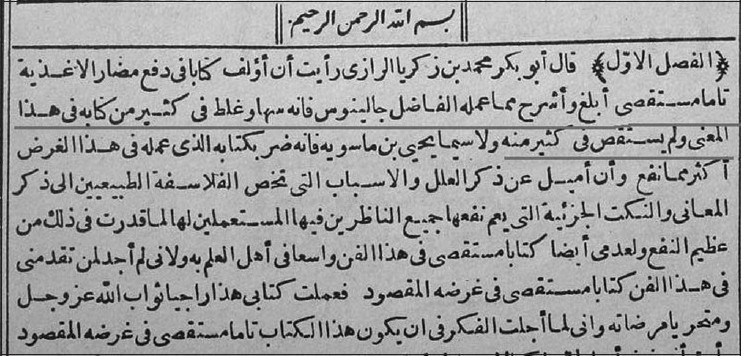
Part of page 2 of Al-Razi's book on diet therapy Manafie al-Aghdhiyah wa Dafei Madharrihah[7] with added underlining to highlight relevant text
“…I decided to author a complete and wide-ranging book on how to keep away the side effects (harm) of nutrients. I decided to make the book more self-explanatory and comprehensive than the work compiled by the honorable Galen. That is because Galen in his book on the same topic overlooked, went wrong and failed to cover the subject fully in many areas..”[7]
Al-Razi's reliance on his own observation, experience, and experimentation is also quite obvious in all sections of his encyclopedic work Al-Hawi (Liber Continens)[8] as well as in other works.[9–11] He even authored a separate treatise titled Kitab Al-Shukuk Ala Galinus (Doubts About Galen) in which he discussed various points of contradiction he had with Galen's medical views.[12]
This scientific critical attitude is also evident in Al-Razi's practice as frequently seen in his Al-Hawi book when commenting on drugs described by predecessors, or by contemporaries, but not tried by him. In such instances, he usually states that he has to verify the validity of the mentioned drug actions.
He was also the first to doubt the belief, prevalent among the ancients that breaking of a bladder stone inside the bladder during or before its removal endangers the patient's life.[13] In his book Al-Hawi, after citing that Antylus, the second century Greek scholar adhered to that belief, Al-Razi commented, “This is to be looked into, God willing”.[14]
Ibn Sina (Avicenna, 980–1037 AD) basically followed the methodical, analytical line originated by Al-Razi in all his works. Here is just an example from the section on simple drugs in his famous Kitab Al-Qanun Fi Al-Tib (The Canon of Medicine):
“{Bladder stone}:
Some people stated that the stone formed in the urinary bladder if [prepared as medication and] drunk by a patient suffering from the same condition, will dissolve [his] bladder stones. And this is among the medicines I do not approve.”[15]
The same scientific method of reliance on direct observation, experience, and experimentation is also evident in works of all the other Islamic medical scholars subject of this study. For an example, in his book Sharh Tashrih Al-Qanun (Commentary on the Anatomy of the Canon), the 13th century Ibn Al-Nafis (1210–1288), stated that,“…However as regard the function of organs, we rely only on what is dictated by investigative observations and accurate research; not caring whether it conformed with, or differed from, the opinions of those who came before us.”[16]
II. Clinical observation and case reports
A new rational approach to the care of patients was also developed by Al-Razi early in the ninth century. His rational approach was based on recording, interpreting and classifying his clinical and experimental observations. This original approach established the methodology of clinical medicine and differential diagnosis and made a lasting impact on Islamic medicine. In contrast to the lack of recorded case histories in the tenth-century Latin tradition, Al-Razi's medical practice as a clinician is attested by hundreds of case histories.
Scholars who came after Al-Razi like Ibn Sina, Al-Zahrawi (Albucasis, 936–1013), Ibn Zuhr (Avenzoar, 1091–1162), Muhadhdhab Al-Deen Al-Baghdadi (1117–1213), and Ibn Al-Nafis continued to follow and enrich his pioneering school giving prime importance to clinical observations and differential diagnosis. They all were keen on recording and classifying their clinical experience in the form of case histories, reports of medical experiences, and a wide variety of clinical accounts.[17–19] This is in agreement with Cumston who described the Islamic physicians as keen observers who excelled in diagnosis and prognosis with their description of symptoms showing a precision and an originality that could be only obtained by direct study of the disease.[20]
III. Clinical therapeutic trials
Deliberate case-control experiments designed to assess, upon patients, the value of therapeutic procedures are an essential feature of modern medicine. It is, therefore, interesting to find out that Al-Razi, more than one thousand years ago planned, carried out and reported the findings of such an experiment. In the section on meningitis of his Al-Hawi book he stated the following [Figure 2]:
Figure 2.
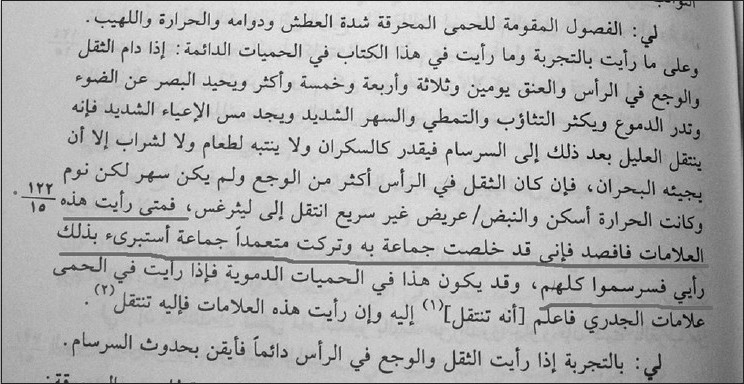
Part of page 2297, volume 15 of Al-Razi's book Al-Hawi (Liber Continens)[21] with added underlining to highlight relevant text
“…So whenever you see these signs [prodromal signs and symptoms of meningitis], go for venesection for the reason that I did save a group [of patients] by using it while deliberately leaving another in order to verify my point of view; they all [the second group] developed meningitis.[21]
Obviously, from the 18th century onwards, bloodletting is generally no more used as a therapeutic modality. However, this experiment highlights the pioneering role of Al-Razi in initiating the case-control method of experimentation in clinical medicine. Islamic scholars who came after him followed and developed the same scientific method. The following is another clear example of a case-control therapeutic trial in the Al-Taisir book [Simplification Concerning Therapeutics and Diet] of Ibn Zuhr [Figure 3]:
Figure 3.
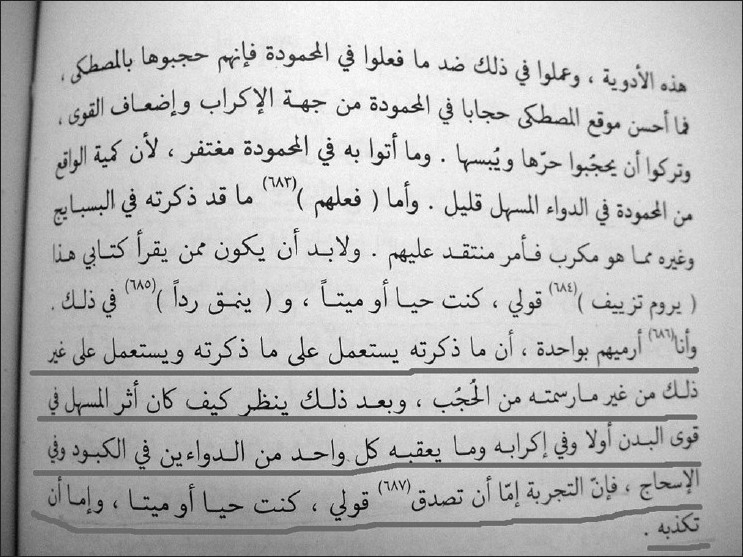
Part of page 326 of Ibn Zuhr's book Al-Taisir Fi Al-Mudawat Wa Al-Tadbeer[22] with added underlining to highlight relevant text
“It is bound to happen, whether I am still alive or dead, that some of the readers of my book will aim at misrepresenting my opinions [on laxatives and how to counteract its side effects]. Hence, they may compose a refutation for that purpose. Then I will challenge them to one [contest]: let them utilize the medicines I mentioned in the same way I prescribed and utilize it in a different way. Then, the effects and side effects of each method are to be recorded. Certainly the experiment will either validate or invalidate my opinion whether I was then alive or dead.”[22]
Ibn Zuhr, then, elaborated on how experimentation is far more accurate and reliable than syllogism in finding truth and providing evidence. He concluded by emphasizing that, “Experimentation is the only way to prove truth and dismiss fallacy”[Figure 4].[22]
Figure 4.
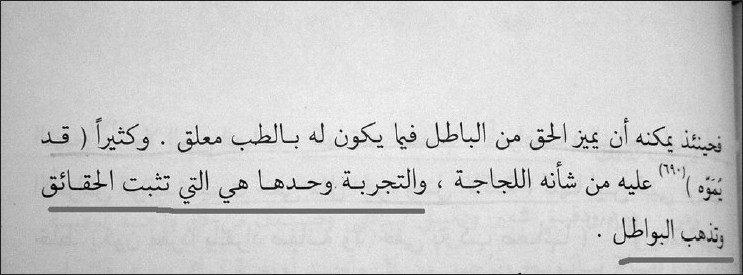
Part of page 327 of Ibn Zuhr's book Al-Taisir Fi Al-Mudawat Wa Al-Tadbeer[22] with added underlining to highlight relevant text
IV. Drug potency trials
The second book (kitab) of Ibn Sina's Canon located in the first volume of the Bulaq Edition is assigned to simple basic drugs (Al Adwiyah Al Mufradah). In the second chapter (maqalah) of its first section (jumlah) titled “On testing for the potency of drugs through experimentation (tajribah)”, Ibn Sina states the following [Figure 5]:
Figure 5.

Part of page 224, vol. 2 of Ibn Sina’ Kitab Al-Qanum Fi Al-Tibb (The Canon of Medicine, Bulaq Edition).[23]
“The potency of drugs’ nature (Amzija) can be identified in two ways, one of them is analogy (qiyas) the other is by way of experimentation (tajribah). And let us start with discussing experimentation. So, we say that experimenting leads to confident knowledge of the potency of the medicine after taking into consideration certain conditions.”[23]
Ibn Sina, then, specified seven rules that need to be taken into account while performing the drug-testing experiment. He discussed in details the importance of each prerequisite emphasizing the need to know them all. In agreement with other authors,[24–27] that chapter is a landmark in the development of the scientific method for testing of drugs and is remarkably consistent with modern concepts. Furthermore, the set of rules described in the 13th century Europe by Peter of Spain (Petrus Hispanus) and by John of St. Amand for determining efficacy in therapeutics[2,28] are very similar to those described by Ibn Sina three centuries earlier.
V. Experimentation on animals
a) To test safety of drugs
The first recorded account of animal experimentation on the toxicity of medicines comes from Al-Razi (Rhazes) in the ninth century who is known to have given monkeys doses of mercury to test its safety for human use as documented by the 13th century Ibn Al-Baytar in his book Al-Jamie Limufradat Al-Adwiya Wal-Aghdiya (Complete Book of Simple Medicaments and Nutritious Items) [Figure 6].[29]
Figure 6.

Part of page 178, vol. 2 of Ibn Al-Baytar. Al-Jamie Limufradat Al-Adwiya Wal-Aghdiya (Complete Book of Simple Medicaments and Nutritious Items).[29]
b) To test the safety of surgical procedures
The role of tracheostomy in the resuscitation of life-threatening suffocation due to upper airway obstruction remained controversial for several centuries. This state of affairs lasted until the Islamic era when AI-Razi (ninth century) and later Ibn Sina (tenth century) spoke favourably of the operation and refined the technique.[17]
Al-Zahrawy, in his book Al-Tasrif Liman Ajaz Aan Al-Taalif (The Disposal of Medical Knowledge to He Who Is Not Able to Get it by Himself From The Other Compilations) reported from his own experience the successful management of a suicidal cut wound of the trachea and concluded that tracheotomy is not a dangerous procedure.[17] However, controversy continued in the time of Ibn Zuhr who reports in Al-Taisir that he has not seen the operation done. Accordingly, in order to find out the truth about the safety of this surgical procedure, he decided to do the experiment explained in the following excerpt from his book Al-Taisir:
“Earlier on in my training when I read those opinions (controversies), I cut on the lung pipe (wind pipe, trachea) of a goat after incising the skin and the covering sheath underneath. Then I completely cut off the substance of the pipe an area just less than the size of a tirmisah (lupine seed). Then I kept washing the wound with water and honey till it healed and it (the animal) totally recovered and lived long time.”[30]
This unique experiment represents a further step in the development of the experimental school started by Al-Razi. Ibn Zuhr's application of an experimental model to a clinical problem was the first ever reported use of experimental surgery. It was the forerunner of the method by which many current surgical procedures were developed. The authors who came after AI-Zahrawy and Ibn Zuhr such as Muhdhdhab Al-Deen AI-Bagdadi and Ibn Al-Quff (1232–1286) recommended tracheotomy unreservedly in life-threatening upper airway obstruction not relieved by other means, and described the technique with more refinements and in more detail.[17] According to Sayili, the 15th century Cerafdin Subuunguglu also recommended tracheostomy in such cases.[31]
VI. Dissection and dissection experiments
We have shown that Al-Razi, Ibn Sina, Muhadhdhabul Din Al-Baghdadi, Ibn Zuhr, and Ibn Rushd emphasized the value of dissection and knowledge of anatomy in medical education and practice.[17,18,32] Also a similar view was held by the 13th century Islamic physician Ibn Al-Nafis, the discoverer of the coronary and pulmonary circulations, in his book Sharh Tashrih Al-Qanun.[19]
Furthermore, the presence of anatomical drawings within the textbooks authored by the Islamic scholars is a trend that started and flourished in the Islamic era reflecting the role of direct observations and experience in dissection.[18,19]
Therefore, contrary to the generally accepted current impression, the interest and practical experience of medieval Islamic scholars in the study of anatomy led them to contribute to the advance of this important medical science, by correcting many of Galen's erroneous anatomical concepts.[17–19,32,33]
The following translated quotations from Sharh Tashreeh Al-Qanun are some other examples of how Ibn Al-Nafis, using his own anatomical observations, disproved other Galenic doctrines which were taken for granted for several hundred years:
“As regard his statement (the statement of Galen accepted by Ibn Sina) that the heart has 3 ventricles: this cannot be correct because the heart has only 2 ventricles. Indeed dissection disproves what they said.”[34]
“Galen's attribution of the nourishment of the heart to the blood in the right ventricle can never be accepted as true, because the nourishment of the heart is actually from the blood passing to it in the vessels situated in its substance.”[35]
The reliance of medieval Islamic scholars on experimentation for the verification of knowledge is further demonstrated by the following translation from Kitab Al-Ifadah wa Al-Itibar (Book of Utility and Reflection) by Muwaffaq Al-Deen Abdel-Latif Al-Baghdady (1162-1231):
“…So with regard to the shape, proportion and relations of bones and joints [in the large number of the examined human skeletons], we have gained knowledge that we could not obtain from books either because of being overlooked [by its authors] or because of lack of textual clarity or because our findings are different from what is written in those books. Indeed, direct observation is stronger evidence than hearing [what is written by others]. And although Galen was of the highest qualities in checking and verifying what he reports, direct observation is a more true [source of knowledge] than him. Then an attempt can be made, if possible, to think of an explanation for his views. Among those [discrepancies] is the lower jaw bone which all agreed to describe as consisting of two separate bones joined at the chin by a strong joint. And, at this point, when we say “all agreed” we actually mean Galen alone because he was the one who devotedly practiced dissection by himself and composed several books about it; most of those books are available to us but the rest are still not in Arabic.
However, based on our own observations, this organ [mandible] is, first and foremost, one bone only without a joint or a symphysis. Using various methods of testing, we examined it repeatedly, as many times as willed by Allah, in many specimens whose number exceeded two thousand skulls; but from all aspects we did not find it except as a single bone. We also arranged the assistance of a separated group who examined it [the mandible] in our presence and then in our absence. They did not add anything to our observations and reporting”[Figure 7].[36–38]
Figure 7.
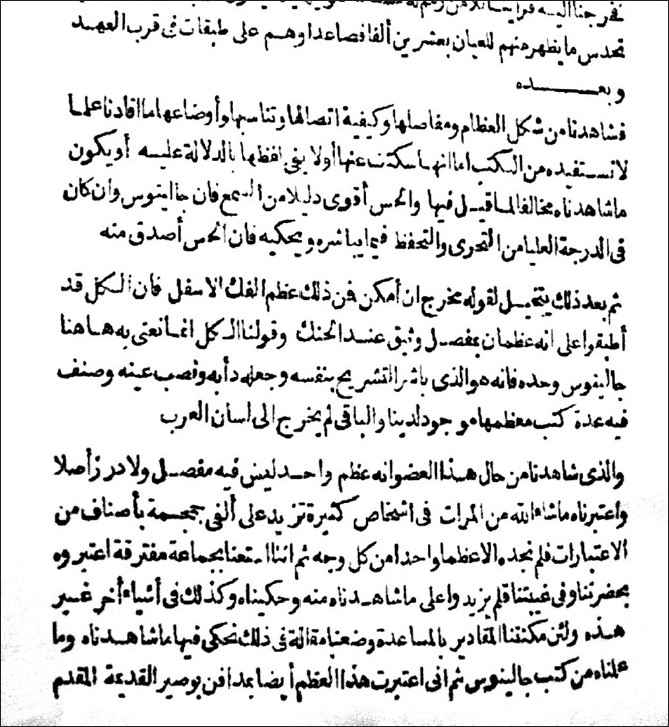
Part of page 61 of Muwaffaq al-Din Abd al-Latif Al-Baghdadi's book Kitab al-ifadah wa-al-ietibar (Book of Utility and Reflection).[36]
This unique anatomical experiment is another vivid documentation of the scientific mentality and experimental methodology of the scholars during the Islamic Era. The large number of the examined specimens also reflects their awareness of the statistical importance of the sample size in determining the significance of findings. Moreover, in order to avoid any possibility of bias, Muwaffaqul Din Al-Baghdady repeated his experiment three times; first on his own, then together with a group of scholars and finally by another group of scholars on their own.[36,37] To achieve accuracy of results, he also utilized more than one method of testing.
VII. Post mortem examinations
a) On animals
The following translation from Al-Taisir of Ibn Zuhr shows how he used experimentation on animals in his search for evidence in the course of looking for a treatment for lung ulcerations:
“….Thus remedies for lung ulcerations are there around in the universe but are yet unknown to us. That is because sheep when caught with a lung disease do leave the herd and wander about as if looking for something; shepherds say for a plant to eat and when they finish eating it their illness is relieved completely and are back to normal. I did inspect lungs of sheep with the evident effect of breach of continuity and with obvious evidence of healing and union. Up till now I did not know that medicine and I do think no one before me knew it either.”[39]
b) On human beings
Furthermore, Ibn Zuhr's description of the pericardial effusion in patients with serous pericarditis as “looking like urine”[40,41] matches well with the current description of this fluid as “straw colored”.[42] This, also, indicates that he had seen and observed a collection of a fluid that could have never been obtained except by either pericardiocentesis or post-mortem examination. On the other hand, Ibn Zuhr's description of “solid substances accumulating on the inside of the heart's covering looking like layers upon layers of membranes”[40] could not have been made possible without carrying out a post-mortem dissection. This is in line with the emphasis laid by his predecessors in the Islamic Era on the importance of a thorough knowledge of anatomy for both physicians and surgeons.
CONCLUSION
From the above-mentioned findings, it can be concluded that the rise of experimental medicine in its modern concept, including clinical trials, drug-potency studies, experimentation on animals and description of the true structure and function of the human body, was set in motion during the Medieval Islamic era as early as the ninth century.
Footnotes
Source of Support: Nil
Conflict of Interest: None.
REFERENCES
- 1.Haeger K. Medicine becomes a science. In: Leuven JV, editor. The illustrated history of surgery. New York: Bell Publishing Company; 1988. pp. 117–22. [Google Scholar]
- 2.Daly WJ, Brater DC. Medieval contributions to the search for truth in clinical medicine. Perspect Biol Med. 2000;43:530–40. doi: 10.1353/pbm.2000.0037. [DOI] [PubMed] [Google Scholar]
- 3.Claridge JA, Fabian TC. History and development of evidence-based medicine. World J Surg. 2005;29:547–53. doi: 10.1007/s00268-005-7910-1. [DOI] [PubMed] [Google Scholar]
- 4.Norton S. Experimental therapeutics in the renaissance. J Pharmacol Exp Ther. 2003;304:489–92. doi: 10.1124/jpet.102.042291. [DOI] [PubMed] [Google Scholar]
- 5.Drake S. Renaissance music and experimental science. J Hist Ideas. 1970;31:483–500. [Google Scholar]
- 6.Kheirandish E. Footprints of “experiment” in early Arabic optics. Early Sci Med. 2009;14:79–104. doi: 10.1163/157338209x425515. [DOI] [PubMed] [Google Scholar]
- 7.Al-Razi(Rhazes) Kitab Manafie al-Aghdhiyah wa-Dafei Madarrihah. Beirut: Dar Sadir, Undated Offset Reprint. 1st ed. Cairo: Al Matbaa Al Khayriaa; 1305 H (1888 CE). p. 2. [Google Scholar]
- 8.Al-Razi(Rhazes) Kitab Alhawi Fi Al Tibb (Rhazes Liber Continens) 1st ed. Vol. 10. Hyderabad: Dairatul Maarif Al-Osmania; 1961. [Google Scholar]
- 9.Al-Razi . Kitab Al-Mansouri. Manuscript No. 3997. Dublin: The Chester Beatty Library; [Google Scholar]
- 10.Al-Razi . In: Ma al-fariq aw al furooq aw kalamun fi al furuuq bain al amradd. Salman Q, editor. Aleppo [Syria]: Institute for Arabic Scientific Heritage; 1978. [Google Scholar]
- 11.Al-Razi . In: Akhlaq Al Tabeeb. 1st ed. Al-Abd AM, editor. Cairo: Maktabit Dar Al-Turath; 1977. [Google Scholar]
- 12.Mukhtar AM. Rhazes contra Galenum. Bonn: Rheinischen Friedrich-Wihelms-Universitat; 1969. [Google Scholar]
- 13.Abdel-Halim RE, Altwaijiri AS, Elfaqih SR, Mitwalli AH. Extraction of urinary bladder stone as described by Abul-Qasim Khalaf Ibn Abbas Alzahrawi (Albucasis) (325-404 H, 930-1013 AD). A translation of original text and a commentary. [Last cited on 2010];Saudi Med J. 2003 24:1283–91. Available from: http://www.rabieabdelhalim.com/zahrawiBladderStoneExtraction.pdf . [PubMed] [Google Scholar]
- 14.Al-Razi AM. Kitab al-Hawi fit-tibb. Hyderabad: Osmania Oriental Publications, Osmania University; 1961. Edited by the Bureau (Rhazes, Liber continens) p. 114. [Google Scholar]
- 15.Translated from: Ibn Sina. Kitab Al-Qanun Fi Al-Tibb (The Canon of Medicine) Vol. 1. Cairo: Bulaq Edition; 1877. Book 2; p. 326. [Google Scholar]
- 16.Qattaya S, editor. Translated from: Ibn Al-Nafis. Cairo: al Hayaa al Masreyya al Aamma Lillkitab; 1988. Kitab Sharh Tashreeh al-Qanon; p. 17. [Google Scholar]
- 17.Abdel-Halim RE. Contributions of Ibn Zuhr (Avenzoar) to the progress of surgery: A study and translations from his book Al-Taisir. [Last cited on 2010];Saudi Med J. 2005 26:1333–9. Available from: http://www.rabieabdelhalim.com/01Contribution20050521.pdf . [PubMed] [Google Scholar]
- 18.Abdel-Halim RE. Contributions of Muhadhdhab Al-Deen Al-Baghdadi to the progress of medicine and urology. A study and translations from his book Al-Mukhtar. [Last cited on 2010];Saudi Med J. 2006 27:1641–41. Available from: http://www.rabieabdelhalim.com/AlbaghdadiContributionsReprint.pdf . [PubMed] [Google Scholar]
- 19.Abdel-Halim RE. Contributions of Ibn Al-Nafis (1210-1288 AD) to the progress of medicine and urology: A study and translations from his medical works. [Last cited on 2010];Saudi Med J. 2008 29:13–22. Available from: http://www.rabieabdelhalim.com/IbnAl-Nafis.pdf . [PubMed] [Google Scholar]
- 20.Cumston CG. Islamic medicine. In: Cumston CG, editor. An introduction to the history of medicine from the time of the pharaohs to the end of the XVIII century. London [UK], New York, [NW]: Kegan Paul, Trench, Trumbner and Co Ltd, Alfred A Knopf; 1926. pp. 192–3. [Google Scholar]
- 21.Translated from: Al-Razi(Rhazes) Vol. 15. Beiurt Edition: Dar Al-Kutub Al-Elmeyyah; 2000. Kitab Al Hawi Fi Al-Tibb (Rhazes’ Liber Continens) p. 2297. Part 5, (corresponds to page 122, Volume 15 of the Hyderabad edition: Hyderabad: Dairatul Maarif Al-Osmania; 1961-1963) [Google Scholar]
- 22.Al-Khoori M, editor. Kitab Al-Taisir Fi Al-Mudawat Wa Al-Tadbeer. Translated from: Ibn Zuhr. (1st ed) 1983;1 and 2:326–7. [Google Scholar]
- 23.Translated from: Ibn Sina (Avicenna) Vol. 1. Cairo: Bulaq; 1877. Kitab Al-Qanum Fi Al-Tibb (The Canon of Medicine) p. 224. The second Maqalah, first Jumalah, the second Kitab, undated Reprint by Dar Sadir. [Google Scholar]
- 24.Bull JP. The historical development of clinical therapeutic trials. J Chronic Dis. 1959;10:218–48. doi: 10.1016/0021-9681(59)90004-9. [DOI] [PubMed] [Google Scholar]
- 25.Nasser M, Tibi A, Savage-Smith E. Ibn Sina's Canon of Medicine: 11th century rules for assessing the effects of drugs. The James Lind Library. [last accessed on 2007]. Available from: http://www.jameslindlibrary.org . [DOI] [PMC free article] [PubMed]
- 26.Sajadi MM, Mansouri D, Sajadi MR. Ibn Sina and the clinical trial. Ann Intern Med. 2009;150:640–3. doi: 10.7326/0003-4819-150-9-200905050-00011. [DOI] [PubMed] [Google Scholar]
- 27.Nasser M, Tibi A, Savage-Smith E. Ibn Sina's Canon of Medicine: 11th century rules for assessing the effects of drugs. J R Soc Med. 2009;102:78–80. doi: 10.1258/jrsm.2008.08k040. [DOI] [PMC free article] [PubMed] [Google Scholar]
- 28.Brater DC, Daly WJ. Clinical pharmacology in the Middle Ages: Principles that presage the 21st century. Clin Pharmacol Ther. 2000;67:447–50. doi: 10.1067/mcp.2000.106465. [DOI] [PubMed] [Google Scholar]
- 29.Al-Baytar Ibn. Al-Jamie Limufradat Al-Adwiya Wal-Aghdiya (Complete Book of Simple Medicaments and Nutritious Items) Vol. 2. Cairo, Baghdad: Al Matbaa Al Ameereyya Al Masreyya 1291 H, 1874AD. Undated Offset edition: Al-Muthana Bookshop; p. 178. [Google Scholar]
- 30.Al-Khoori M. Translated from: Ibn Zuhr (Avenzoar) 1st ed. 1 and 2. Damascus: Darul Fikr Press for the Arab Educational Scientific and Cultural Organization; 1983. Kitab Al-Taisir Fi Al-Mudawat Wa Al-Tadbeer; p. 149. [Google Scholar]
- 31.Sayili Aydin M. Turkish medicine. Isis. 1937;26:403–14. [Google Scholar]
- 32.Abdel-Halim RE, Abdel-Maguid TE. The functional anatomy of the ureterovesical junction: A historical review. [Last cited on 2010];Saudi Med J. 2003 24:815–9. Available from: http://www.rabieabdelhalim.com/Thefunctional.pdf . [PubMed] [Google Scholar]
- 33.Abdel-Halim RE. The missing link in the history of urology: A call for more efforts to bridge the gap? [Last cited on 2010];Urol Ann. 2009 1:2–8. Available from: http://www.urologyannals.com/article.asp?issn=0974-7796;year=2009;volume=1;issue=1;spage=2;epage=8;aulast=Abdel-Halim . [Google Scholar]
- 34.Qattaya S. Translated From: Ibn Al-Nafis. Cairo: The Supreme Council for Culture and the Egyptian Book Bureau Manuscript Editing Centre; 1988. Kitab Sharh Tashreeh al-Qanon; p. 388. [Google Scholar]
- 35.Al-Nafis Ibn. In: Kitab Sharh Tashreeh al-Qanon. Qattaya S, editor. Cairo: The Supreme Council for Culture and the Egyptian Book Bureau Manuscript Editing Centre; 1988. p. 389. [Google Scholar]
- 36.Translated from: Al-Baghdadi, Muwaffaq al-Din Abd al-Latif. Cairo: Wadi Al Neel Press; 1281 H (1864 AD). Kitab al-ifadah wa-al-ietibar: Fi al-umur al-mushahadah wa-al-hawadith al-muaayanah bi-ard Misr: qissat al-majaºah al-kubrá bi-Misr aam 600H; pp. 61–2. [Google Scholar]
- 37.Al-Shaikh AA, editor. Translated from: Al-Baghdadi, Muwaffaq al-Din Abd al-Latif. 2nd ed. Cairo: The Supreme Council for Culture and the Egyyptian Book Bureau Manuscript Editing Centre; 1998. Kitab al-ifadah wa-al-ietibar: Fi al-umur al-mushahadah wa-al-hawadith al-muaayanah bi-ard Misr: qissat al-majaºah al-kubrá bi-Misr aam 600H; pp. 149–50. [Google Scholar]
- 38.Baidoun F, Dusoky K, Al-Khouri ME, editors. Al-Baghdadi, Muwaffaq al-Din Abd al-Latif. Beirut: Dar al-Afaq al-Jadida; 1981. Kitab al-ifadah wa-al-ietibar: Fial-umur al-mushahadah wa-al-hawadith al-muaayanah bi-ard Misr: qissat al-majaºah al-kubrá bi-Misr aam 600H. Quoted by: Sigrid Hunke, Allah.s Sonne Uber Dem Abendland Unser Arabisches Erbe, Arabic Translation; pp. 270–1. [Google Scholar]
- 39.Al-Khoori M, editor. Translated from: Ibn Zuhr. 1st ed. 1 and 2. Damascus: Darul Fikr Press for the Arab Educational Scientific and Cultural Organization; 1983. Kitab Al-Taisir Fi Al-Mudawat Wa Al-Tadbeer; p. 129. [Google Scholar]
- 40.Al-Khoori M, editor. Translated from: Ibn Zuhr. 1st ed. 1 and 2. Damascus: Darul Fikr Press for the Arab Educational Scientific and Cultural Organization; 1983. Kitab Al-Taisir Fi Al-Mudawat Wa Al-Tadbeer; p. 183. [Google Scholar]
- 41.Abdel-Halim RE, Elfaqih SR. Pericardial pathology 900 years ago. A study and translations from an Arabic medical textbook. [Last cited on 2010];Saudi Med J. 2007 28:323–5. Available from: http://www.rabieabdelhalim.com/PericardialPathologyIbnZuhr.pdf . [PubMed] [Google Scholar]
- 42.DeBono DP, Boon NA. Diseases of the cardiovascular system. In: Edwards CR, Bouchier IA, editors. Davidson's principles and practice of medicine. Edinburgh: ELBS Churchill Livingstone; 1991. pp. 306–8. [Google Scholar]


